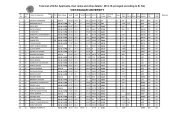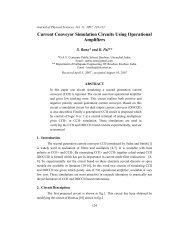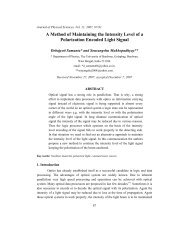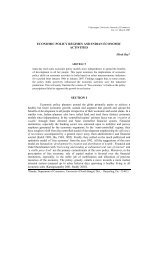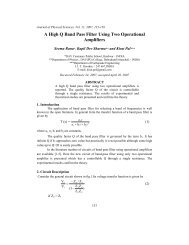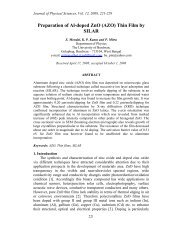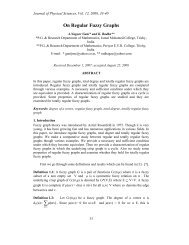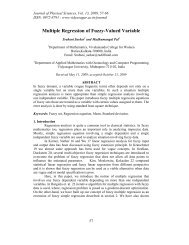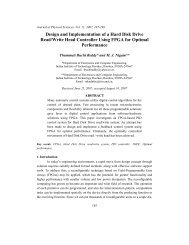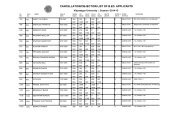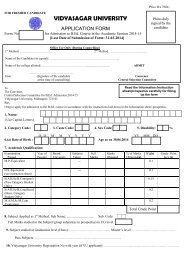VIDYASAGAR UNIVERSITY JOURNAL OF COMMERCE
VIDYASAGAR UNIVERSITY JOURNAL OF COMMERCE
VIDYASAGAR UNIVERSITY JOURNAL OF COMMERCE
You also want an ePaper? Increase the reach of your titles
YUMPU automatically turns print PDFs into web optimized ePapers that Google loves.
WTO AND INDIA: TIME FOR RENAISSANCE <strong>OF</strong> THE FARM SECTOR<br />
Concerns of the Farm Sector<br />
Indian farm sector is now at the crossroads. It is now standing at a juncture where hurricane<br />
efforts are required for its revival. Continuous decline in its performance has attracted the<br />
attention of all policy makers. Farming is now at the centre of attention more than ever<br />
before. It is still the backbone of the economy due to the high dependency on it and also due<br />
to supply of basic necessity of life i.e., food. Government gave priority for the growth of the<br />
farm sector and adopted several measures but nothing prominent came out of it. The biggest<br />
concerns of the farm sector are low production and low productivity. India is ranked second<br />
after China in terms of its population growth. Due to low production and high growth rate of<br />
population, the per capita availability of foodgrains is also on a decline.<br />
Indian farm sector’s concerns of low production and low productivity are the impacts of<br />
problems existing in the farm sector. The real concern ranges from the pressure of<br />
population to land reforms. The first and foremost reason of low productivity of farm sector<br />
is the excess pressure of population on farming. Insufficient irrigation facility and<br />
corresponding enhanced reliance on monsoon, which again is highly uncertain and uneven<br />
create challenge on production and productivity. The nature of the soil is also not uniform.<br />
Some farm lands are more fertile and some are less. Farmers with lack of financial and<br />
technical support are able to do less for the replenishment of lost fertility. The soil health and<br />
water management are the principal reasons for the low production and low productivity<br />
besides other causes. The other issues are inadequate finance with the Indian farmers to use<br />
improved inputs, small size of land holdings which are even less than the average size to use<br />
mechanized farming, and cropping pattern, which is need based and not on the suitability of<br />
their land. The following table (Table-2) highlights the fluctuating foodgrains production<br />
pattern from 1990-91 to 2005-06, and the subsequent table (Table-3) highlights the<br />
productivity of India vis-à-vis the world.<br />
Group/<br />
Commodity<br />
Unit 1990-<br />
1991<br />
Table-2: Production of Major Crops<br />
1999-<br />
2000<br />
2000-<br />
2001<br />
2001-<br />
2002<br />
2002-<br />
2003<br />
2003-<br />
2004<br />
(In Million Tonnes)<br />
2004-<br />
2005<br />
2005-<br />
2006*<br />
Cereals Tonnes 162.1 196.4 185.7 199.5 163.6 198.3 185.2 195.2<br />
Rice Tonnes 74.3 89.7 85.0 93.3 71.8 88.5 83.1 91.0<br />
Wheat Tonnes 55.1 76.4 69.7 72.8 65.8 72.2 68.6 69.5<br />
Pulses Tonnes 14.3 13.4 11.0 13.3 11.1 14.9 13.1 13.1<br />
Oil-Seeds** Tonnes 18.6 20.7 18.4 20.6 14.8 25.2 24.4 27.7<br />
Cotton Bales@ 9.8 11.5 9.5 10.0 8.6 13.7 16.4 19.6<br />
Sugarcane Tonnes 241.0 299.3 296.0 297.2 287.4 233.9 237.1 278.4<br />
* - 4 th Advance Estimates, ** - Include groundnut, rapeseed & mustard, sesamum, linseed, castorseed, nigerseed,<br />
safflower, sunflower and soybean, @ - Bale of 170 Kgs.<br />
Sources: 1. Directorate of Economics & Statistics, Department of Agriculture & Cooperation, Govt. of<br />
India.<br />
Vidyasagar University Journal of Commerce 95




